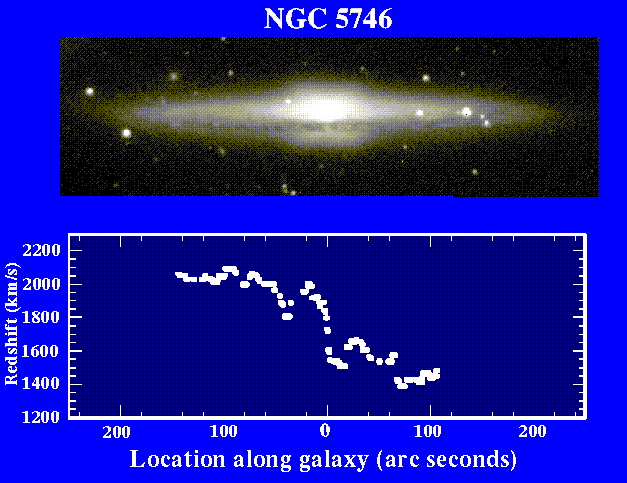NGC 5746 and its rotation curve
 Seen edge-on, the arms of spiral galaxies become difficult to trace,
but we have an excellent view of the thickness of the disk containing
the arms and of the absorbing dust which is concentrated there.
NGC 5746 is a good example, showing intricate detail in the dust
layer but little evidence of what its detailed spiral pattern looks like.
The accompanying diagram shows the rotation curve of this galaxy -
the velocity measured spectroscopically by the redshift of light from
stars and gas orbiting at larger and larger distances from the
center level off without observable reduction to the limits
of the observations - a so-called flat rotation curve. This is some of
the premier evidence that many galaxies contain large amounts of
unseen material, more widely spread than the stars and gas, whose
effects we see only through its gravitational impact on the material
that we can observe. In many galaxies, estimates of the relative amounts
of luminous and invisible matter show that the ``dark matter" outweighs
what we can see - sometimes by as much as ten times.
The image is a red-light CCD frame taken by W.C. Keel at the 1.1-meter
(42-inch) Hall telescope of Lowell Observatory. The rotation curve was
measured using the GoldCam CCD spectrometer at the 2.1-meter (84-inch)
telescope of Kitt Peak National Observatory.
Seen edge-on, the arms of spiral galaxies become difficult to trace,
but we have an excellent view of the thickness of the disk containing
the arms and of the absorbing dust which is concentrated there.
NGC 5746 is a good example, showing intricate detail in the dust
layer but little evidence of what its detailed spiral pattern looks like.
The accompanying diagram shows the rotation curve of this galaxy -
the velocity measured spectroscopically by the redshift of light from
stars and gas orbiting at larger and larger distances from the
center level off without observable reduction to the limits
of the observations - a so-called flat rotation curve. This is some of
the premier evidence that many galaxies contain large amounts of
unseen material, more widely spread than the stars and gas, whose
effects we see only through its gravitational impact on the material
that we can observe. In many galaxies, estimates of the relative amounts
of luminous and invisible matter show that the ``dark matter" outweighs
what we can see - sometimes by as much as ten times.
The image is a red-light CCD frame taken by W.C. Keel at the 1.1-meter
(42-inch) Hall telescope of Lowell Observatory. The rotation curve was
measured using the GoldCam CCD spectrometer at the 2.1-meter (84-inch)
telescope of Kitt Peak National Observatory.
 UA Astronomy Home Page
UA Astronomy Home Page
 Seen edge-on, the arms of spiral galaxies become difficult to trace,
but we have an excellent view of the thickness of the disk containing
the arms and of the absorbing dust which is concentrated there.
NGC 5746 is a good example, showing intricate detail in the dust
layer but little evidence of what its detailed spiral pattern looks like.
The accompanying diagram shows the rotation curve of this galaxy -
the velocity measured spectroscopically by the redshift of light from
stars and gas orbiting at larger and larger distances from the
center level off without observable reduction to the limits
of the observations - a so-called flat rotation curve. This is some of
the premier evidence that many galaxies contain large amounts of
unseen material, more widely spread than the stars and gas, whose
effects we see only through its gravitational impact on the material
that we can observe. In many galaxies, estimates of the relative amounts
of luminous and invisible matter show that the ``dark matter" outweighs
what we can see - sometimes by as much as ten times.
The image is a red-light CCD frame taken by W.C. Keel at the 1.1-meter
(42-inch) Hall telescope of Lowell Observatory. The rotation curve was
measured using the GoldCam CCD spectrometer at the 2.1-meter (84-inch)
telescope of Kitt Peak National Observatory.
Seen edge-on, the arms of spiral galaxies become difficult to trace,
but we have an excellent view of the thickness of the disk containing
the arms and of the absorbing dust which is concentrated there.
NGC 5746 is a good example, showing intricate detail in the dust
layer but little evidence of what its detailed spiral pattern looks like.
The accompanying diagram shows the rotation curve of this galaxy -
the velocity measured spectroscopically by the redshift of light from
stars and gas orbiting at larger and larger distances from the
center level off without observable reduction to the limits
of the observations - a so-called flat rotation curve. This is some of
the premier evidence that many galaxies contain large amounts of
unseen material, more widely spread than the stars and gas, whose
effects we see only through its gravitational impact on the material
that we can observe. In many galaxies, estimates of the relative amounts
of luminous and invisible matter show that the ``dark matter" outweighs
what we can see - sometimes by as much as ten times.
The image is a red-light CCD frame taken by W.C. Keel at the 1.1-meter
(42-inch) Hall telescope of Lowell Observatory. The rotation curve was
measured using the GoldCam CCD spectrometer at the 2.1-meter (84-inch)
telescope of Kitt Peak National Observatory.
 UA Astronomy Home Page
UA Astronomy Home Page